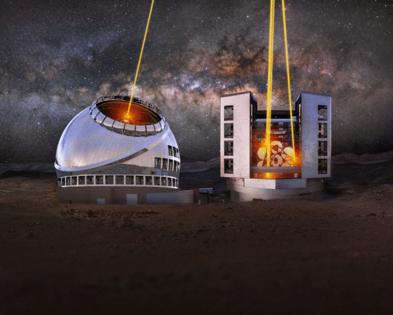Commentary: America's 'big glass' dominance hangs on the fate of two powerful new telescopes
Published in Science & Technology News
More than 100 years ago, astronomer George Ellery Hale brought our two Pasadena institutions together to build what was then the largest optical telescope in the world. The Mount Wilson Observatory changed the conception of humankind’s place in the universe and revealed the mysteries of the heavens to generations of citizens and scientists alike. Ever since then, the United States has been at the forefront of “big glass.”
In fact, our institutions, Carnegie Science and Caltech, still help run some of the largest telescopes for visible-light astronomy ever built.
But that legacy is being threatened as the National Science Foundation, the federal agency that supports basic research in the U.S., considers whether to fund two giant telescope projects. What’s at stake is falling behind in astronomy and cosmology, potentially for half a century, and surrendering the scientific and technological agenda to Europe and China.
In 2021, the National Academy of Sciences released Astro2020. This report, a road map of national priorities, recommended funding the $2.5 billion Giant Magellan Telescope at the peak of Cerro Las Campanas in Chile and the $3.9 billion Thirty Meter Telescope at Mauna Kea in Hawaii. According to those plans, the telescopes would be up and running sometime in the 2030s.
NASA and the Department of Energy backed the plan. Still, the National Science Foundation’s governing board on Feb. 27 said it should limit its contribution to $1.6 billion, enough to move ahead with just one telescope. The NSF intends to present their process for making a final decision in early May, when it will also ask for an update on nongovernmental funding for the two telescopes. The ultimate arbiter is Congress, which sets the agency’s budget.
America has learned the hard way that falling behind in science and technology can be costly. Beginning in the 1970s, the U.S. ceded its powerful manufacturing base, once the nation’s pride, to Asia. Fast forward to 2022, the U.S. government marshaled a genuine effort toward rebuilding and restarting its factories — for advanced manufacturing, clean energy and more — with the Inflation Reduction Act, which is expected to cost more than $1 trillion.
President Joe Biden also signed into law the $280 billion CHIPS and Science Act two years ago to revive domestic research and manufacturing of semiconductors — which the U.S. used to dominate — and narrow the gap with China.
As of 2024, America is the unquestioned leader in astronomy, building powerful telescopes and making significant discoveries. A failure to step up now would cede our dominance in ways that would be difficult to remedy.
The National Science Foundation’s decision will be highly consequential. Europe, which is on the cusp of overtaking the U.S. in astronomy, is building the aptly named Extremely Large Telescope, and the United States hasn’t been invited to partner in the project. Russia aims to create a new space station and link up with China to build an automated nuclear reactor on the moon.
Although we welcome any sizable grant for new telescope projects, it’s crucial to understand that allocating funds sufficient for just one of the two planned telescopes won’t suffice. The Giant Magellan and the Thirty Meter telescopes are designed to work together to create capabilities far greater than the sum of their parts. They are complementary ground stations. The GMT would have an expansive view of the southern hemisphere heavens, and the TMT would do the same for the northern hemisphere.
...continued
©2024 Los Angeles Times. Visit at latimes.com. Distributed by Tribune Content Agency, LLC.







Comments